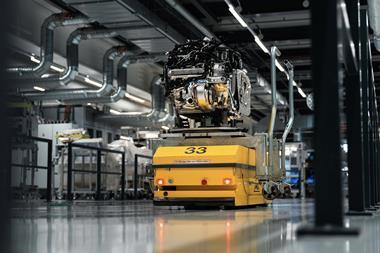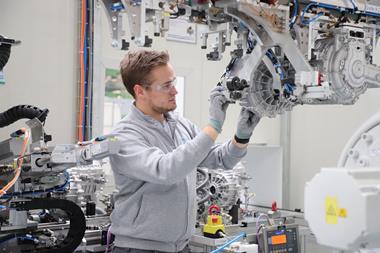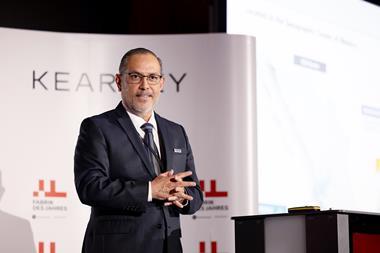
GOM’s 3D Metrology Conference continued the tradition of showcasing the latest in industrial 3D metrology, inspection and testing to automotive manufacturing professionals from around the world
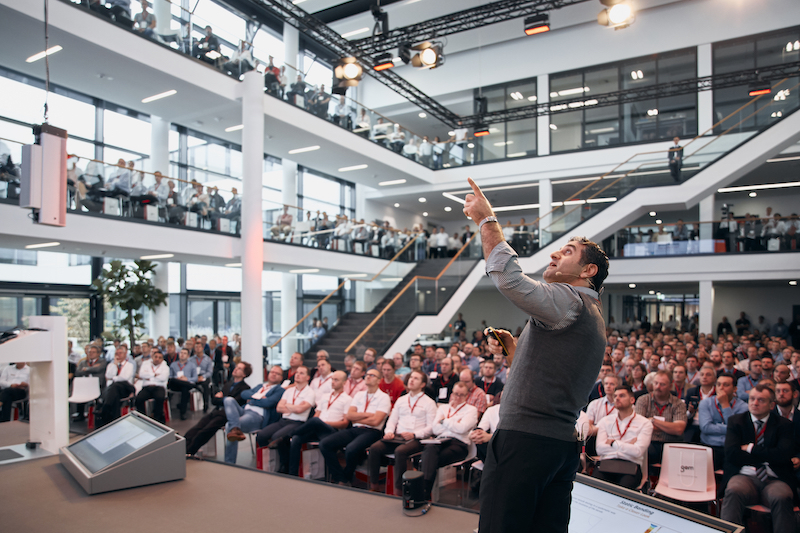 With more than 750 visitors from more than 50 countries, the GOM Conference proved again to be an established forum for experts in metrology, quality control and product development. In presentations on 3D testing and 3D metrology, GOM introduced cross-industry topics, providing insight into the workflows of renowned companies. Speakers from VW, Porsche, BMW and Opel presented their experience with GOMs metrology systems.
With more than 750 visitors from more than 50 countries, the GOM Conference proved again to be an established forum for experts in metrology, quality control and product development. In presentations on 3D testing and 3D metrology, GOM introduced cross-industry topics, providing insight into the workflows of renowned companies. Speakers from VW, Porsche, BMW and Opel presented their experience with GOMs metrology systems.
The conference identified several key headings that are active within the industry right now:• Automated measuring cells and mobile metrology• Sensor technology and software for quality control• Automotive industry, aerospace, power generation, medical technology and consumer goods• Optimisation of injection moulding, casting and sheet metal forming processes• Inspection concepts and tolerance management: GD&T and PMI• Materials and components testing
It was made clear by the international lecture programme that optical metrology is already successfully established across entire production process chains; from materials testing, design and mould-making through to production-related quality control.
Solution tracksThe relations between OEMs and suppliers are directly correlated to their profitability and competitiveness. Especially OEMs need to understand the difference between process improvement and work relations improvement.
It’s a point that the GOM Conference addresses by focussing on both process improvement by optical measuring technology and on the other hand relationship improvements, bringing automakers, suppliers and research scientists together to discuss standards and share knowledge.
Between plenary presentations, the interactive solution tracks provided parallel sessions on a variety industry-specific topics to discuss solution-driven applications. Among others, they captured Tolerance Management, Global Supply Chain Management as well as Airfoil Inspection and Manufacturing Process Control.
Discussions heard reiterated the importance of maintaining a close relationship between supplier and OEM when producing parts. It is not a straightforward process, and both sides need to use their collective strengths to ensure the end product is functional and attractive. With the conference’s focus on production quality control, optical metrology is a standard that takes OEMs and suppliers forward. In other words, GOM offers an opportunity to achieve successful contact.
Several OEMs and research organisations spoke from first-hand experience about how the implementation of optical metrology reduces development times, improves process safety and optimises production processes. Participants included:
Audi • BMW • Canmet • Daimler • DTU • Liebherr • Metalsa • Opel • Porsche • Rolls-Royce • SAIC Volkswagen • Sandvik • Tata Steel • ThyssenKrupp Presta • Topia • Volkswagen Commercial Vehicles • ZF
The reorientation from tactile to optical, full-field measuring technology is due to the completeness and comprehensibility of the results provided. The non-contact and full-field coordinate measuring technology enables to achieve a density of information that is not possible by tactile means.
During the conference it became clear that GOM is doing a lot of work with regard to software. Especially the virtual assembly feature of the ATOS ScanBox — a development that is being implement by many OEMs. For example, SAIC Volkswagen (SVW), who gave a presentation about its experience with digital assembly.
Using the ATOS system, its Meisterbock gauging stage was reduced from 11 days down to just three. This includes the scan of the car body, pressed parts, hang-on and sub-assemblies as well as a surface view with flush-and-gap. It represents a 40% time reduction of optical solution compared with the tactile method previously used.

“Instead of comparing real components, 3D point clouds are the base for our analysis of parts,” Hans-Uwe Horlbeck of SVW said.
The OEM is already using virtual assembly for production process improvement, a topic that came up repeatedly during the conference. Dr Torsten Putze of Porsche also commended GOM’s virtual assembly tools and the cost reduction, improved inside view and time savings that can be achieved.
The core of the ATOS ScanBox Series 7 and 8 is the ATOS Triple Scan sensor, which provides precise and complete measuring results of individual sheets, assemblies and complete BIWs. The high quality of the measuring results forms the basis of the virtual assembly.
Prior to the actual physical assembly, the measured parts are virtually aligned, such that information on gap and flush or functional dimensions can be evaluated at an early stage. All parts can be measured at different locations. Measuring results deriving from press or body shops or suppliers are virtually merged by the manufacturer, where they can be evaluated centrally.
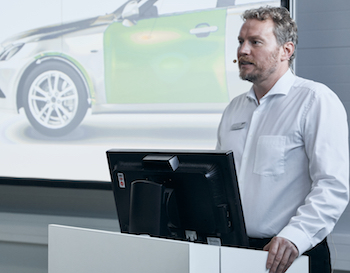 Dr Carsten Reich, GOM director for automation, speaking at the solution track session on Production Control and SPC
Dr Carsten Reich, GOM director for automation, speaking at the solution track session on Production Control and SPCIn this way, a car body can be analysed with the individual parts compared against CAD. The fitting of the sheet metal parts and assemblies to the BIW can be inspected. This includes functional dimensions, gap sizes and information on flush. Moreover, the evaluation of character lines and feature lines as well as trimmed edges and hole patterns is made possible.
It’s location-independent cubing – the data set of the virtual assembly can be adjusted at any time. If parts must be exchanged or measured later, a fast transformation into the global data set is possible via a reference point system. Therefore, individual parts or assemblies are positioned distinctively and reproducibly to the vehicle coordinate system. This way, the fitting of the individual parts is perfectly aligned, and errors affecting the functionality or production can be detected and corrected at an early stage.
Optical roll-outAll major automotive manufacturers are replacing tactile measuring systems with optical solutions such as the ATOS ScanBox, as are suppliers such as Gedia and Gestamp.
The new Volkswagen plant at Wrzesnia, Poland is a key example of the roll-out of optical measuring systems. The facility has adopted non-contact measuring technology almost exclusively. Cooperation along the supply chain means that Gestamp is delivering parts to the Wrzesnia plant which have already been measured with ATOS systems to VW’s absolute specification.
At Opel too, a roll-out to replace tactile metrology systems is underway. The system collects 3D measuring data from different plants for use at an early production development stage.
Closing the event, GOM’s director Dr Konstantin Galanulis said: “If we look at ATOS Scanbox Series 7 and 8, these systems have now been on the market for nearly two years. We are only at the very beginning and there are so many things to discover.”


























